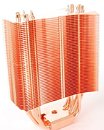Wednesday, September 17th 2008
Thermalright Ultra 120 Cu Limited Edition up for Grabs Next Month
Famous for their fin-array based air cooling, Thermalright had earlier announced that they would be releasing a full-copper version of their popular Ultra 120 CPU cooler. Reports suggest that the cooler indeed will make it to the market next month, just that the company would be making only 3,000 of these coolers making it a limited-edition product. The cooler uses copper in all its parts, starting from the CPU contact base, the six heatpipes, and the 50+ fins. With copper being a heavier metal than aluminum, the heatsink tips the scales at a whole 3 kilograms (roughly 6 lbs). The thermal properties of copper along with an element of aesthetic appeal would sell this product, which will be priced at US $99 when it releases next month.
Source:
Expreview

83 Comments on Thermalright Ultra 120 Cu Limited Edition up for Grabs Next Month
Anyway, looks nice. But that heat sink is really only practical in a horizantal installation. Maybe your motherboard wouldnt break right away, but with the varieing temperatures from CPU load/idleness, not even to think about the added ambient temperature fluctations... Sooner than later it will at least get some damage there.
Anyway... sounds like a nice solution for a HTPC and passive cooling:cool: (or at least very low airflow then:p)
In that particular test they review the Ninja 100% Cu with the original Ninja. Very interesting test, especially since the all Cu Ninja only wins over the newer Ninja ver. B, and not the old Ninja.
The most dependent factor is actually the tension between the heatsink and the CPU.
Hence, all of the coolers with copper bottoms and aluminum fins (plus Al is just a lot cheaper).
And NO! It is NOT Aloominium. :banghead:
The wikipedia explaination: en.wikipedia.org/wiki/Bong_cooler
There are many other sites out there too that will show you just about any way possible to make one of these bong type coolers. When setup properly, there is no radiator out there that would beat one of these (since no traditional radiator will ever cool below ambient). The only problem is that it is an open system so biocide is necessary but with the evaporation taking place that biocide will also make it into the surrounding air, that also means you always need to keep a close eye on your water levels.
Edit: Also, it's not really water and air reacting. It's water changing from its liquid state to its gaseous state (evaporation) which takes lots of energy. That is why this form of cooling is so effective.
One last edit: I didn't mean that to come off as pissy but it kind of looked that way after I read it.
I tell you what. We'll heat a 12 guage piece of Cu and Al wire up to 200F and them cool for a few secs. Which wire are you going to grab?
That's what I thought.
I guess I should also say that if we're talking about solid copper or solid Al, then yeah, copper is superior. You need to transfer that heat away quickly. But with a hybrid (what I was talking about in the beginning, should've clarified) you should get a slightly better temp.
And I also may be completely retarded, can't ever rule that one out.
I lived in Phoenix Arizona one summer, we had what is known as a "Swamp Cooler" on the house which used water evaporation (basically a big box with water dripping through fiber mats and a blower), and even when it was 45°-50° outside, it was a comfortable 23°-25° inside.
And the water is reacting with the air. Actually, the water vapor in the air, is reacting with the liquid water. Evaporation is actually caused by a reaction of the material to itself. The molecules collide(react) with eachother and transfer energy, if one gets enough energy to change state, evaperation happens. Now, the water vapor in the air is also reacting with the liquid water. As the water vapor in the air collides(reacts) with the liquid water, it often takes the energy from a molecule that would normally have enough energy to change states. This is the reason that water evaporates more slowly when the air is humid. There are more water molecules in the air colliding with the liquid water molecules and preventing them from changing state.
As for the cooler, 6lbs is a bit more than Im willing to put on my cpu to keep it cool. Its ridiculous. And Ambient temperature pretty much supersedes most anything. With the exception of LN2, Phase, and TEC, it pretty much governs what the temps are. Funny thing about water, does it cool better than air? Yes if its a good system. It also removes heat alot quicker and returns to ambient alot quicker, than say a great air cooler.
reference.techpowerup.com/Bong_cooling